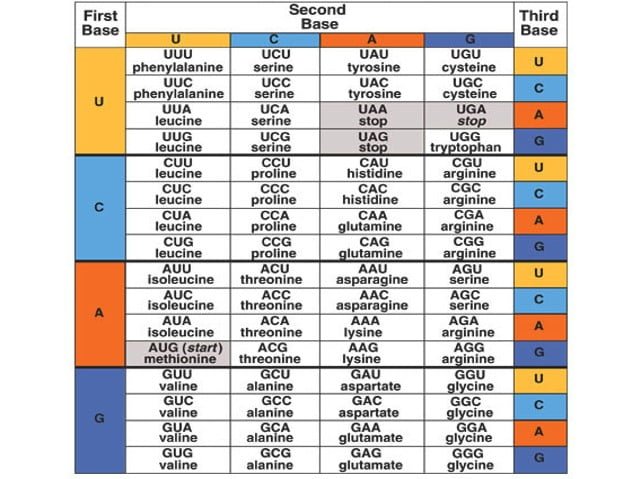It is a well-known fact that DNA influences an organism’s genetic structure. DNA contains all the information that is passed down from one generation to the next and from one set of cells to another. What kinds of proteins should be produced is determined by a gene? A gene’s deoxyribonucleotide can influence the sort of protein that is produced. This indicates that the sequence of deoxyribonucleotide bases in DNA and the sequence of amino acids in proteins have a specific link. The genetic code describes how amino acids and nucleotide bases interact. It has codons, each of which stands for a different amino acid. Therefore, the genetic code is a collection of base sequences for each amino acid.
https://thesciencenotes.com/watson-and-crick-double-helix-model-of-dna/ https://thesciencenotes.com/genetic-code/
DNA molecules contains 3 types of components:
- Phosphoric acid
- Deoxyribose sugar
- Nitrogenous base
All deoxyribonucleotides share phosphoric acid and deoxyribose sugar. they merely make up the DNA’s backbone. Nitrogen bases exhibit differences (A, T, C and G). Therefore, the arrangement of amino acids in proteins is determined by the sequence of nitrogenous bases.
Properties of genetic code

- Code is triplet
DNA contains four different types of nitrogen bases (A, T, C, and G), but there are twenty different types of amino acids. Only 4 different types of amino acids would be coded if each nitrogen base only codes one amino acid. A triplet code (a code of three nitrogen bases) will result in sixty-four codes, but a double code (a code of two nitrogen bases) will result in sixteen codes, which are likewise insufficient to describe twenty amino acids. Only twenty different types of amino acids exist. Therefore, twenty different types of amino acids can be specified by sixty-four codes. The term “codon” refers to the three nearby nitrogen bases in an m-RNA or DNA sequence that identify one amino acid. UUU, for instance, designates phenylalanine, while GUC, valine. The nitrogen base sequence is read in the 5′ -3′ direction.
- Code is non- overlapping
There are numerous methods to create a triplet code; for instance, AUGCAUGGACUCAAC can have multiple codes. AUG, GGA, GAC, CUC, CAA, and AAC. The neighboring codon, however, does not exhibit any overlap. One nitrogen base, G, is present in both codons in the examples AUG and GCA shown above. The above codons are incorrect since each single base is a component of only one codon. The codons from the nitrogenous base sequence above are AUG, CAU, GGA, C UC, and AAC. In above examples, there are 15 nitrogenous bases a codon is triplet and non -overlapping.so, number of codons is always equals to number of nitrogen bases in mRNA divided by three.
- Code is commaless
There are two types of triplet codons: punctuated and unpunctuated. Nitrogen bases that are present after a codon are included in the following codon and do not serve as commas. Assume that the sequence UGCUUGCGC may contain an A (which is absent in the preceding list), but that an A cannot exist between UGC and UUG. U is a component of the following codon after UGC. Ugh, that doesn’t work as a comma. The genetic code lacks commas. It denotes the absence of a gap between two codons. Reading of the code start from 5’ -3’ directions without a pause till termination codon, which indicates the end of the code.
- Code is degenerate
20 amino acids are coded by 61 codons (three codons do not code amino acids). The number of codons is more than the number of amino acids. As a result, many codons can be employed for a single amino acid. Degeneracy of code is the term used to describe several coding systems. for illustration. Serine is one of the amino acids, and its six codons are UCU, UCC, UCA, UUG, AGU, and AGC. The four codons GUU, GUC, GUA, and GUG code for valine. Except for methionine and tryptophan, all amino acids are determined by more than one codon. Synonymous codons are those that encode the same amino acids. They usually differ in third nitrogen base (wobble position).
- Unambiguity of code
The genetic code’s degenerate character, as stated above, has demonstrated that the identical amino acids are encoded by more than one codon. Experimental results confirmed that a codon always specifies a certain type of amino acid. For instance, AAA always denotes lysine rather than phenylalanine.
- Code is universal
The genetic code’s degenerate character, as stated above, has demonstrated that the identical amino acids are encoded by more than one codon. Experimental results confirmed that a codon always specifies a certain type of amino acid. For instance, AAA always denotes lysine rather than phenylalanine.
- Initiation codon
An initiation codon is a codon that appears at the beginning of a gene or mRNA. https://thesciencenotes.com/rna-basic-structure-functions-and-types-of-rna/
The initiation codon, AUG (rarely GUG), starts off the synthesis of polypeptide chains. AUG is a methionine code.
- Nonsense codon
A few codons, such UAA, UAG, and UGA, indicate the end of a polypeptide chain but do not identify an amino acid. They are also referred to as nonsense, termination, or stop codons.
- Collinearity
The order of codons in DNA or mRNA and the order of amino acids in polypeptide chains are both organized in a linear fashion, or the code and amino acid sequences in polypeptide chains are co-linear. A specific codon changes in DNA results in a change in the amino acid at the corresponding location in the polypeptide.
https://www.genome.gov/genetics-glossary/Genetic-Code